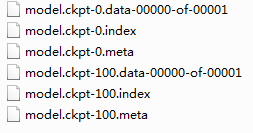您好,登錄后才能下訂單哦!
您好,登錄后才能下訂單哦!
利用卷積神經網絡訓練圖像數據分為以下幾個步驟
1.讀取圖片文件
2.產生用于訓練的批次
3.定義訓練的模型(包括初始化參數,卷積、池化層等參數、網絡)
4.訓練
1 讀取圖片文件
def get_files(filename): class_train = [] label_train = [] for train_class in os.listdir(filename): for pic in os.listdir(filename+train_class): class_train.append(filename+train_class+'/'+pic) label_train.append(train_class) temp = np.array([class_train,label_train]) temp = temp.transpose() #shuffle the samples np.random.shuffle(temp) #after transpose, images is in dimension 0 and label in dimension 1 image_list = list(temp[:,0]) label_list = list(temp[:,1]) label_list = [int(i) for i in label_list] #print(label_list) return image_list,label_list
這里文件名作為標簽,即類別(其數據類型要確定,后面要轉為tensor類型數據)。
然后將image和label轉為list格式數據,因為后邊用到的的一些tensorflow函數接收的是list格式數據。
2 產生用于訓練的批次
def get_batches(image,label,resize_w,resize_h,batch_size,capacity):
#convert the list of images and labels to tensor
image = tf.cast(image,tf.string)
label = tf.cast(label,tf.int64)
queue = tf.train.slice_input_producer([image,label])
label = queue[1]
image_c = tf.read_file(queue[0])
image = tf.image.decode_jpeg(image_c,channels = 3)
#resize
image = tf.image.resize_image_with_crop_or_pad(image,resize_w,resize_h)
#(x - mean) / adjusted_stddev
image = tf.image.per_image_standardization(image)
image_batch,label_batch = tf.train.batch([image,label],
batch_size = batch_size,
num_threads = 64,
capacity = capacity)
images_batch = tf.cast(image_batch,tf.float32)
labels_batch = tf.reshape(label_batch,[batch_size])
return images_batch,labels_batch
首先使用tf.cast轉化為tensorflow數據格式,使用tf.train.slice_input_producer實現一個輸入的隊列。
label不需要處理,image存儲的是路徑,需要讀取為圖片,接下來的幾步就是讀取路徑轉為圖片,用于訓練。
CNN對圖像大小是敏感的,第10行圖片resize處理為大小一致,12行將其標準化,即減去所有圖片的均值,方便訓練。
接下來使用tf.train.batch函數產生訓練的批次。
最后將產生的批次做數據類型的轉換和shape的處理即可產生用于訓練的批次。
3 定義訓練的模型
(1)訓練參數的定義及初始化
def init_weights(shape):
return tf.Variable(tf.random_normal(shape,stddev = 0.01))
#init weights
weights = {
"w1":init_weights([3,3,3,16]),
"w2":init_weights([3,3,16,128]),
"w3":init_weights([3,3,128,256]),
"w4":init_weights([4096,4096]),
"wo":init_weights([4096,2])
}
#init biases
biases = {
"b1":init_weights([16]),
"b2":init_weights([128]),
"b3":init_weights([256]),
"b4":init_weights([4096]),
"bo":init_weights([2])
}
CNN的每層是y=wx+b的決策模型,卷積層產生特征向量,根據這些特征向量帶入x進行計算,因此,需要定義卷積層的初始化參數,包括權重和偏置。其中第8行的參數形狀后邊再解釋。
(2)定義不同層的操作
def conv2d(x,w,b): x = tf.nn.conv2d(x,w,strides = [1,1,1,1],padding = "SAME") x = tf.nn.bias_add(x,b) return tf.nn.relu(x) def pooling(x): return tf.nn.max_pool(x,ksize = [1,2,2,1],strides = [1,2,2,1],padding = "SAME") def norm(x,lsize = 4): return tf.nn.lrn(x,depth_radius = lsize,bias = 1,alpha = 0.001/9.0,beta = 0.75)
這里只定義了三種層,即卷積層、池化層和正則化層
(3)定義訓練模型
def mmodel(images): l1 = conv2d(images,weights["w1"],biases["b1"]) l2 = pooling(l1) l2 = norm(l2) l3 = conv2d(l2,weights["w2"],biases["b2"]) l4 = pooling(l3) l4 = norm(l4) l5 = conv2d(l4,weights["w3"],biases["b3"]) #same as the batch size l6 = pooling(l5) l6 = tf.reshape(l6,[-1,weights["w4"].get_shape().as_list()[0]]) l7 = tf.nn.relu(tf.matmul(l6,weights["w4"])+biases["b4"]) soft_max = tf.add(tf.matmul(l7,weights["wo"]),biases["bo"]) return soft_max
模型比較簡單,使用三層卷積,第11行使用全連接,需要對特征向量進行reshape,其中l6的形狀為[-1,w4的第1維的參數],因此,將其按照“w4”reshape的時候,要使得-1位置的大小為batch_size,這樣,最終再乘以“wo”時,最終的輸出大小為[batch_size,class_num]
(4)定義評估量
def loss(logits,label_batches): cross_entropy = tf.nn.sparse_softmax_cross_entropy_with_logits(logits=logits,labels=label_batches) cost = tf.reduce_mean(cross_entropy) return cost 首先定義損失函數,這是用于訓練最小化損失的必需量 def get_accuracy(logits,labels): acc = tf.nn.in_top_k(logits,labels,1) acc = tf.cast(acc,tf.float32) acc = tf.reduce_mean(acc) return acc
評價分類準確率的量,訓練時,需要loss值減小,準確率增加,這樣的訓練才是收斂的。
(5)定義訓練方式
def training(loss,lr): train_op = tf.train.RMSPropOptimizer(lr,0.9).minimize(loss) return train_op
有很多種訓練方式,可以自行去官網查看,但是不同的訓練方式可能對應前面的參數定義不一樣,需要另行處理,否則可能報錯。
4 訓練
def run_training():
data_dir = 'C:/Users/wk/Desktop/bky/dataSet/'
image,label = inputData.get_files(data_dir)
image_batches,label_batches = inputData.get_batches(image,label,32,32,16,20)
p = model.mmodel(image_batches)
cost = model.loss(p,label_batches)
train_op = model.training(cost,0.001)
acc = model.get_accuracy(p,label_batches)
sess = tf.Session()
init = tf.global_variables_initializer()
sess.run(init)
coord = tf.train.Coordinator()
threads = tf.train.start_queue_runners(sess = sess,coord = coord)
try:
for step in np.arange(1000):
print(step)
if coord.should_stop():
break
_,train_acc,train_loss = sess.run([train_op,acc,cost])
print("loss:{} accuracy:{}".format(train_loss,train_acc))
except tf.errors.OutOfRangeError:
print("Done!!!")
finally:
coord.request_stop()
coord.join(threads)
sess.close()
神經網絡訓練的時候,我們需要將模型保存下來,方便后面繼續訓練或者用訓練好的模型進行測試。因此,我們需要創建一個saver保存模型。
def run_training():
data_dir = 'C:/Users/wk/Desktop/bky/dataSet/'
log_dir = 'C:/Users/wk/Desktop/bky/log/'
image,label = inputData.get_files(data_dir)
image_batches,label_batches = inputData.get_batches(image,label,32,32,16,20)
print(image_batches.shape)
p = model.mmodel(image_batches,16)
cost = model.loss(p,label_batches)
train_op = model.training(cost,0.001)
acc = model.get_accuracy(p,label_batches)
sess = tf.Session()
init = tf.global_variables_initializer()
sess.run(init)
saver = tf.train.Saver()
coord = tf.train.Coordinator()
threads = tf.train.start_queue_runners(sess = sess,coord = coord)
try:
for step in np.arange(1000):
print(step)
if coord.should_stop():
break
_,train_acc,train_loss = sess.run([train_op,acc,cost])
print("loss:{} accuracy:{}".format(train_loss,train_acc))
if step % 100 == 0:
check = os.path.join(log_dir,"model.ckpt")
saver.save(sess,check,global_step = step)
except tf.errors.OutOfRangeError:
print("Done!!!")
finally:
coord.request_stop()
coord.join(threads)
sess.close()
訓練好的模型信息會記錄在checkpoint文件中,大致如下:
model_checkpoint_path: "C:/Users/wk/Desktop/bky/log/model.ckpt-100"
all_model_checkpoint_paths: "C:/Users/wk/Desktop/bky/log/model.ckpt-0"
all_model_checkpoint_paths: "C:/Users/wk/Desktop/bky/log/model.ckpt-100"
其余還會生成一些文件,分別記錄了模型參數等信息,后邊測試的時候程序會讀取checkpoint文件去加載這些真正的數據文件

構建好神經網絡進行訓練完成后,如果用之前的代碼直接進行測試,會報shape不符合的錯誤,大致是卷積層的輸入與圖像的shape不一致,這是因為上篇的代碼,將weights和biases定義在了模型的外面,調用模型的時候,出現valueError的錯誤。

因此,我們需要將參數定義在模型里面,加載訓練好的模型參數時,訓練好的參數才能夠真正初始化模型。重寫模型函數如下
def mmodel(images,batch_size):
with tf.variable_scope('conv1') as scope:
weights = tf.get_variable('weights',
shape = [3,3,3, 16],
dtype = tf.float32,
initializer=tf.truncated_normal_initializer(stddev=0.1,dtype=tf.float32))
biases = tf.get_variable('biases',
shape=[16],
dtype=tf.float32,
initializer=tf.constant_initializer(0.1))
conv = tf.nn.conv2d(images, weights, strides=[1,1,1,1], padding='SAME')
pre_activation = tf.nn.bias_add(conv, biases)
conv1 = tf.nn.relu(pre_activation, name= scope.name)
with tf.variable_scope('pooling1_lrn') as scope:
pool1 = tf.nn.max_pool(conv1, ksize=[1,2,2,1],strides=[1,2,2,1],
padding='SAME', name='pooling1')
norm1 = tf.nn.lrn(pool1, depth_radius=4, bias=1.0, alpha=0.001/9.0,
beta=0.75,name='norm1')
with tf.variable_scope('conv2') as scope:
weights = tf.get_variable('weights',
shape=[3,3,16,128],
dtype=tf.float32,
initializer=tf.truncated_normal_initializer(stddev=0.1,dtype=tf.float32))
biases = tf.get_variable('biases',
shape=[128],
dtype=tf.float32,
initializer=tf.constant_initializer(0.1))
conv = tf.nn.conv2d(norm1, weights, strides=[1,1,1,1],padding='SAME')
pre_activation = tf.nn.bias_add(conv, biases)
conv2 = tf.nn.relu(pre_activation, name='conv2')
with tf.variable_scope('pooling2_lrn') as scope:
norm2 = tf.nn.lrn(conv2, depth_radius=4, bias=1.0, alpha=0.001/9.0,
beta=0.75,name='norm2')
pool2 = tf.nn.max_pool(norm2, ksize=[1,2,2,1], strides=[1,1,1,1],
padding='SAME',name='pooling2')
with tf.variable_scope('local3') as scope:
reshape = tf.reshape(pool2, shape=[batch_size, -1])
dim = reshape.get_shape()[1].value
weights = tf.get_variable('weights',
shape=[dim,4096],
dtype=tf.float32,
initializer=tf.truncated_normal_initializer(stddev=0.005,dtype=tf.float32))
biases = tf.get_variable('biases',
shape=[4096],
dtype=tf.float32,
initializer=tf.constant_initializer(0.1))
local3 = tf.nn.relu(tf.matmul(reshape, weights) + biases, name=scope.name)
with tf.variable_scope('softmax_linear') as scope:
weights = tf.get_variable('softmax_linear',
shape=[4096, 2],
dtype=tf.float32,
initializer=tf.truncated_normal_initializer(stddev=0.005,dtype=tf.float32))
biases = tf.get_variable('biases',
shape=[2],
dtype=tf.float32,
initializer=tf.constant_initializer(0.1))
softmax_linear = tf.add(tf.matmul(local3, weights), biases, name='softmax_linear')
return softmax_linear
測試訓練好的模型
首先獲取一張測試圖像
def get_one_image(img_dir): image = Image.open(img_dir) plt.imshow(image) image = image.resize([32, 32]) image_arr = np.array(image) return image_arr
加載模型,計算測試結果
def test(test_file):
log_dir = 'C:/Users/wk/Desktop/bky/log/'
image_arr = get_one_image(test_file)
with tf.Graph().as_default():
image = tf.cast(image_arr, tf.float32)
image = tf.image.per_image_standardization(image)
image = tf.reshape(image, [1,32, 32, 3])
print(image.shape)
p = model.mmodel(image,1)
logits = tf.nn.softmax(p)
x = tf.placeholder(tf.float32,shape = [32,32,3])
saver = tf.train.Saver()
with tf.Session() as sess:
ckpt = tf.train.get_checkpoint_state(log_dir)
if ckpt and ckpt.model_checkpoint_path:
global_step = ckpt.model_checkpoint_path.split('/')[-1].split('-')[-1]
saver.restore(sess, ckpt.model_checkpoint_path)
print('Loading success)
else:
print('No checkpoint')
prediction = sess.run(logits, feed_dict={x: image_arr})
max_index = np.argmax(prediction)
print(max_index)
前面主要是將測試圖片標準化為網絡的輸入圖像,15-19是加載模型文件,然后將圖像輸入到模型里即可
以上就是本文的全部內容,希望對大家的學習有所幫助,也希望大家多多支持億速云。
免責聲明:本站發布的內容(圖片、視頻和文字)以原創、轉載和分享為主,文章觀點不代表本網站立場,如果涉及侵權請聯系站長郵箱:is@yisu.com進行舉報,并提供相關證據,一經查實,將立刻刪除涉嫌侵權內容。